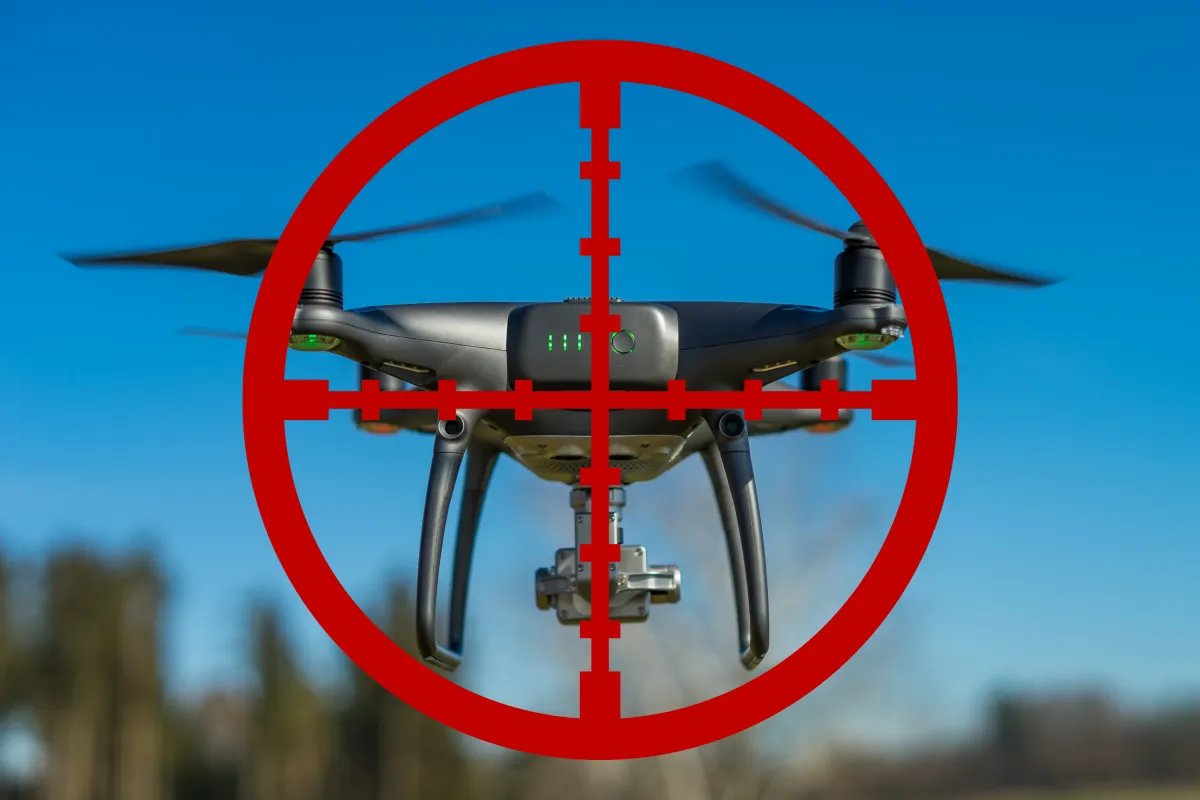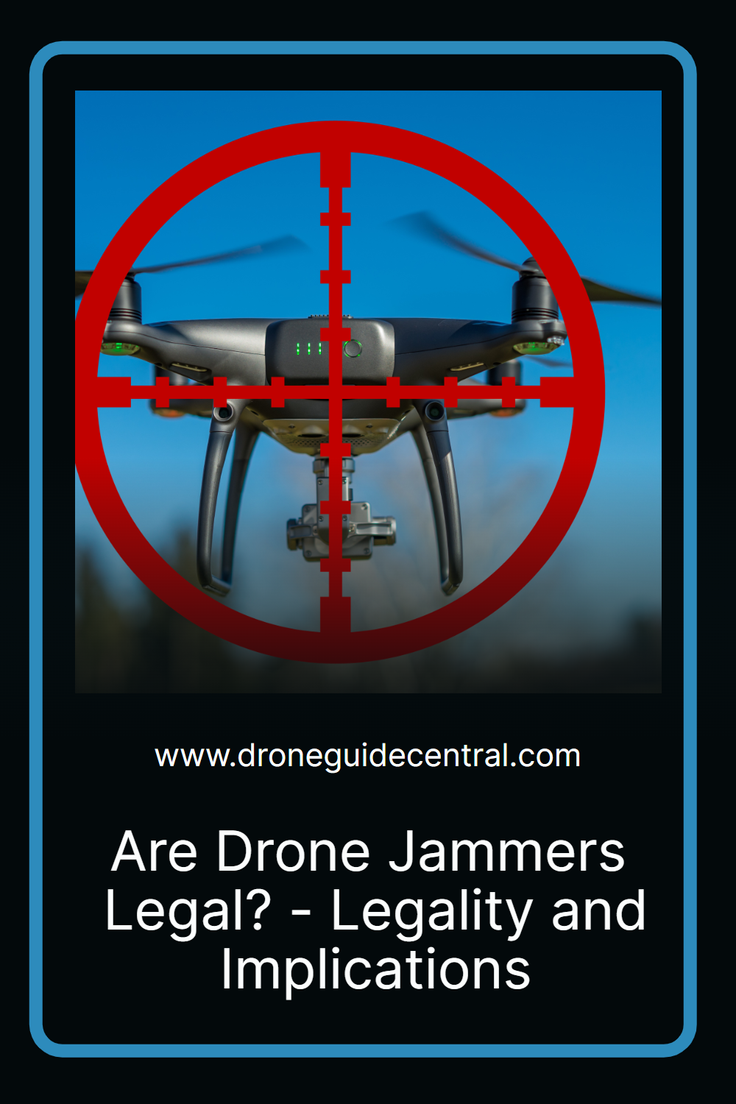
Are Drone Jammers Legal? - Legality and Implications
Drones have become ubiquitous in our skies, capturing breathtaking aerial views and facilitating various industries. However, this surge in drone usage has given rise to concerns, particularly regarding privacy and safety. A topic that often surfaces in these discussions is the legality of using drone jammers. In this comprehensive exploration, we will delve into the world of drone jammers, deciphering their legal status and unraveling the reasons behind the regulations.
Are Drone Jammers Legal?: Understanding Drone Jammers
What are Drone Jammers?
Drone jammers, in essence, are devices designed to disrupt or disable the communication signals between a drone and its operator. These devices leverage advanced jamming technology to interfere with the drone's control signals or GPS reception, effectively countering drone technologies, and leading to a temporary loss of connectivity.
How Drone Jammers Work
Drone jammers operate by emitting radio frequency signals on the same frequencies used by drones for communication. This interference disrupts the connection between the drone and its operator, leading to a loss of control. Some advanced jammers can also target the GPS signals, causing the drone to lose its navigational capabilities.
The Rise of Drones and Privacy Concerns
As drones become more accessible and affordable, concerns about potential privacy infringements have grown. From backyard gatherings to public spaces, the ability of drones to capture images and videos raises valid questions about personal privacy. Understanding the reasons behind the increasing use of drone jammers is crucial for navigating this evolving landscape.
Why Drone Jammers Should Not Be Used?
The use of drone jammers raises significant ethical and legal concerns. Interfering with drone signals can lead to unintended consequences, affecting not only the targeted drone but also communication systems, electronic devices, and potentially jeopardizing public safety. Moreover, the indiscriminate use of jamming technology can infringe upon the rights of responsible drone operators and may lead to legal consequences.
Are Drone Jammers Legal?: Legal Landscape of Drone Jammers
Federal Regulations in the United States
In the United States, for example, the use of drone jammers is generally illegal for private individuals without proper authorization from the Federal Communications Commission (FCC). The FCC regulates the use of radio frequency (RF) devices, and unauthorized interference with communication signals is against the law.
Global Perspectives on Drone Jammer Legality
The legal status of drone jammers varies across different countries. While some nations strictly prohibit their use, others may have more permissive regulations. Understanding the global landscape provides valuable insights into the diverse approaches countries take in addressing the challenges posed by counter drone and anti drone technologies.
Are Drone Jammers Legal?: Challenges and Controversies
Interference with Communication Signals
One of the primary concerns surrounding drone jammers is their potential to interfere with essential radio communications and navigation signals. This interference can extend beyond the intended target, affecting nearby electronic devices, communication systems, and even critical infrastructure. Striking a balance between countering drone threats and avoiding unintended consequences is a complex challenge, especially when considering the potential impact on aircraft and other vital information systems.
Public Safety Implications
The use of drone jammers raises questions about public safety, particularly in crowded areas. Unintended consequences, such as interference with emergency communication systems, must be carefully considered. Balancing the need for enhanced security with potential risks is essential for effective regulation.
How Do You Know If Your Drone Is Jammed?
Determining whether your drone is jammed can be challenging, as it may exhibit various symptoms that can be attributed to different issues. Here are some signs that could indicate your drone is jammed:
Loss of Control:
If you suddenly lose control of your drone and it becomes unresponsive to your commands.
Erratic Behavior:
Jamming signals can cause drones to behave erratically. If your drone starts flying unpredictably or deviates from its intended path without any input from you.
Abnormal LED Lights:
Some drones have indicator lights that signal the status of the connection. If you notice unusual blinking patterns or colors on these lights.
Sudden Height or Altitude Changes:
Jamming signals may disrupt the drone's ability to maintain a stable altitude. If your drone experiences sudden drops or climbs without your input, it could be a sign of jamming.
Loss of GPS Signal:
Jamming devices may target GPS signals, leading to a loss of satellite connectivity. If your drone relies on GPS for navigation and you notice a sudden loss of GPS signal, it could be due to jamming.
Unexpected Return to Home (RTH):
If your drone autonomously initiates a Return to Home (RTH) procedure without your command.
Inability to Take Off or Land:
Jamming signals may interfere with the normal operation of your drone, preventing it from taking off or landing properly.
It's important to note that these symptoms can also be caused by other factors, such as technical malfunctions or environmental conditions. Before concluding that your drone is jammed, consider checking for any local regulations, or potential sources of interference, and verifying the drone's condition and settings.
If you suspect your drone is jammed, it is advisable to land it immediately in a safe location and investigate the cause. Additionally, staying informed about the local regulations regarding the use of drone jammers can help you understand the likelihood of encountering interference in a specific area.
Pros and Cons of Drone Jammers
Advantages of Drone Jammers
Drone jammers offer certain advantages, particularly in scenarios where privacy and security are paramount. They can provide a quick response to potential threats and unauthorized drone activities, making them a valuable tool for law enforcement and security agencies. The use of anti-drone technology becomes especially critical in safeguarding airspace.
Drawbacks and Limitations
However, the drawbacks of drone jammers should not be overlooked. Legal consequences, technological limitations, and ethical concerns surrounding the potential harm to innocent drone operators pose challenges. Striking a balance between addressing concerns and avoiding overreliance on jamming devices is crucial, especially considering the dynamic nature of drone technologies.
Can a Jammer Stop a Drone?
Jamming technology can effectively stop a drone by disrupting its communication signals. When a drone is within the range of a jammer, it loses its ability to receive commands from its operator, resulting in a loss of control.
Can Drone Signals Be Blocked?
Yes, drone signals can be blocked using jamming technology. By emitting signals on the same frequencies as those used by drones, jammers interfere with communication and navigation signals, blocking the drone's ability to operate effectively.
Can You Jam a DJI Drone?
DJI drones, like any other commercially available drones, can be jammed using appropriate jamming devices. However, it's essential to note that interfering with any drone's signals, including those from DJI, may have legal consequences.
Can Commercial Drones Be Jammed?
Commercial drones, regardless of the brand, can be jammed using specialized jamming technology. This capability is a cause for concern in various contexts, prompting the need for clear regulations and restrictions on the use of drone jammers.
Are Drone Jammers Legal?: Navigating the Legal Landscape
Authorized Use Cases
Certain scenarios permit the use of drone jammers, such as authorized government activities or events requiring enhanced security measures. Understanding the specific conditions and obtaining proper authorization is critical to ensuring legal compliance with federal laws and FCC regulations governing the use of jamming technology.
Obtaining Proper Authorization
Individuals or entities seeking to use drone jammers legally must navigate a complex process. Obtaining proper authorization involves adhering to specific requirements, submitting applications, and ensuring compliance with existing regulations to counter UAS (unmanned aircraft system) effectively.
Alternatives to Drone Jammers
Technological Solutions
Exploring alternative technologies that address privacy and safety concerns without resorting to drone jammers is crucial. Signal encryption, geo-fencing, and other counter-drone measures offer viable alternatives that mitigate risks without the potential drawbacks of jamming devices. Additionally, advancements in anti drone technologies provide a diverse array of tools for addressing security concerns.
Educational Initiatives
Promoting education and awareness about responsible drone use is a proactive approach to addressing privacy issues. Training drone operators, implementing clear guidelines, and fostering a culture of responsible drone use can contribute to a more harmonious integration of drones into society.
Cell Phone Interference and Drone Jamming
The technology used in drone jammers can sometimes interfere with cell phone signals. This collateral interference raises additional concerns, as it may impact essential communication systems beyond the intended drone target. Regulating the use of drone jammers becomes even more critical to mitigate such unintended consequences.
Are Drone Jammers Legal?: Conclusion
In conclusion, the legality of drone jammers is a nuanced and evolving topic that requires careful consideration. While drone jammers offer potential solutions to privacy concerns, the legal landscape demands a delicate balance between innovation and regulation. Striking this balance is crucial for the responsible integration of drones into our daily lives, ensuring the coexistence of technology and privacy while complying with federal laws, FCC regulations, and other relevant drone laws.
FAQs about Drone Jammers
Q: Can I purchase a drone jammer for personal use?
A: Generally, personal use of drone jammers is illegal. It is essential to be aware of and comply with local regulations and federal laws to avoid legal consequences.
Q: Are there any exceptions to the prohibition of drone jammers?
A: Some countries allow certain entities, such as law enforcement or government agencies, to use drone jammers under specific circumstances. However, strict guidelines often govern their use to ensure compliance with relevant laws and regulations.
Q: How can I protect my privacy from drones without using a jammer?
A: Explore technological solutions like signal encryption, geo-fencing, and other anti-drone measures to enhance privacy without resorting to jamming. Understanding local regulations and creating awareness about responsible drone use also play key roles in safeguarding privacy.
Q: What legal consequences can arise from the unauthorized use of drone jammers?
A: Unauthorized use of drone jammers can lead to hefty fines, legal action, and the confiscation of the jamming device. It is crucial to obtain proper authorization before deploying such technology.
Q: Why Are Drone Jammers Banned?
A: Drone jammers are banned or heavily regulated due to the potential risks they pose to communication infrastructure, public safety, and the rights of drone operators. The indiscriminate use of jamming technology can lead to unintended disruptions and conflicts, prompting authorities to restrict their usage to authorized entities under controlled circumstances.
Explore further in articles on sciencedirect.com here and here.

Copyright © Drone Guide Central - All Rights Reserved 2024

